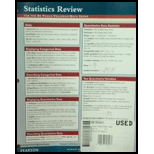
Concept explainers
a.
Check whether who takes out the trash is random.
a.
Answer to Problem 1E
Yes, the person who takes out the trash is random.
Explanation of Solution
A coin is flipped to decide who takes out the trash.
Randomization:
The process of allocating experimental units to the treatments in an experiment using probability is known as randomization.
Randomization minimizes the difference between groups by equally distributing the individuals. By randomization, individuals are assigned to corresponding treatment randomly. Randomization reduces the observer bias, the effect of the order in which the treatments are administered and accounts for the uncontrolled factors in the experiment. Randomization helps to eliminate or reduce the effects of the factors, which cannot be controlled in the experiment.
When the exact prediction of a particular outcome is not possible, then that particular outcome is said to be random.
Here, the experimenter flips a coin to decide who takes out the trash. It is not possible to predict the outcome of a coin when it is tossed. It might be either head or tail.
The experimenter flips a coin and selects a person based on the outcome of the coin. Here, the investigator might select a person if the tossed coin shows head or select a person if the tossed coin shows tail. The outcome of the tossed coin (Either head or tail) is purely random. Thus, a person is randomlyselected to decide the person who takes out the trash according to the outcome.
Hence, the experimenter implements the randomization by randomly assigninga person to take out the trash.
Thus, the person who takes out the trash is random.
b.
Check whether the sports team named by the friend is random.
b.
Answer to Problem 1E
No, the sports team named by the friend is not random.
Explanation of Solution
A sports team is named by asking a friend to quickly name a professional sports team.
Randomization:
The process of allocating experimental units to the treatments in an experiment using probability is known as randomization.
Randomization minimizes the difference between groups by equally distributing the individuals. By randomization, individuals are assigned to corresponding treatment randomly. Randomization reduces the observer bias, the effect of the order in which the treatments are administered and accounts for the uncontrolled factors in the experiment. Randomization helps to eliminate or reduce the effects of the factors, which cannot be controlled in the experiment.
When the exact prediction of a particular is outcome is not possible, then that particular outcome is said to be random.
Here, the sports team is named by asking a friend to quickly name a professional sports team.
The experimenter selects a sports team by asking a friend to quickly name a professional sports team.
Since, a friend knows likes and dislikes of his friendand he might guess the name of the sports team which his friend is about to give. Therefore, the spots team named by friend is predictable. Thus, a sports team named by the friend is not randomly selected.
Hence, the experimenter does not implement randomization.
Thus, the sports team named by friendis not named at random.
c.
Check whether the roommate for the year is random.
c.
Answer to Problem 1E
Yes, the roommate for the year is random.
Explanation of Solution
Names are selected out of a hat to decide roommates in a dormitory.
Randomization:
The process of allocating experimental units to the treatments in an experiment using probability is known as randomization.
Randomization minimizes the difference between groups by equally distributing the individuals. By randomization, individuals are assigned to corresponding treatment randomly. Randomization reduces the observer bias, the effect of the order in which the treatments are administered and accounts for the uncontrolled factors in the experiment. Randomization helps to eliminate or reduce the effects of the factors, which cannot be controlled in the experiment.
When the exact prediction of a particular is outcome is not possible, then that particular outcome is said to be random.
Here, the experimenter selected the roommates in a dormitory by selecting names out of a hat.
The experimenter selects a name out of a hat and decides the roommate based on the outcome of the hat. The names of the roommates in a dormitory which are about to pick by the experimenter is not predictable. Thus, name of roommates in a dormitory is randomly selected by the experimenter.
Hence, the experimenter implements the randomization by randomly selecting the roommate name.
Thus, the roommate for the year is random.
Want to see more full solutions like this?
Chapter 9 Solutions
Intro Stats - Study Card
 MATLAB: An Introduction with ApplicationsStatisticsISBN:9781119256830Author:Amos GilatPublisher:John Wiley & Sons Inc
MATLAB: An Introduction with ApplicationsStatisticsISBN:9781119256830Author:Amos GilatPublisher:John Wiley & Sons Inc Probability and Statistics for Engineering and th...StatisticsISBN:9781305251809Author:Jay L. DevorePublisher:Cengage Learning
Probability and Statistics for Engineering and th...StatisticsISBN:9781305251809Author:Jay L. DevorePublisher:Cengage Learning Statistics for The Behavioral Sciences (MindTap C...StatisticsISBN:9781305504912Author:Frederick J Gravetter, Larry B. WallnauPublisher:Cengage Learning
Statistics for The Behavioral Sciences (MindTap C...StatisticsISBN:9781305504912Author:Frederick J Gravetter, Larry B. WallnauPublisher:Cengage Learning Elementary Statistics: Picturing the World (7th E...StatisticsISBN:9780134683416Author:Ron Larson, Betsy FarberPublisher:PEARSON
Elementary Statistics: Picturing the World (7th E...StatisticsISBN:9780134683416Author:Ron Larson, Betsy FarberPublisher:PEARSON The Basic Practice of StatisticsStatisticsISBN:9781319042578Author:David S. Moore, William I. Notz, Michael A. FlignerPublisher:W. H. Freeman
The Basic Practice of StatisticsStatisticsISBN:9781319042578Author:David S. Moore, William I. Notz, Michael A. FlignerPublisher:W. H. Freeman Introduction to the Practice of StatisticsStatisticsISBN:9781319013387Author:David S. Moore, George P. McCabe, Bruce A. CraigPublisher:W. H. Freeman
Introduction to the Practice of StatisticsStatisticsISBN:9781319013387Author:David S. Moore, George P. McCabe, Bruce A. CraigPublisher:W. H. Freeman





